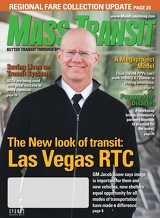Mass Transit magazine features agency profiles, industry trends, management tips and new product information.
Page 21 of 39
FARE COLLECTION
how the new fare collection system worked. T e campaign included radio and television promotion, a comprehen- sive print me- dia
campaign
The Clipper Card serves seven transit operators in the San Francisco Bay area.
in three lan- guages (Eng- lish, Spanish and Creole), communi t y
outreach meetings and interior and exterior bus and rail advertising, ex- plains Damian. Matthews says community outreach
turned out to be one of the hardest parts of the whole project "T e fi rst thing we did on the very
fi rst day of the full system launch is we had a customer education campaign
put together out on the station plat- forms," Matthews says. T e system does not work with Bro-
ward County Transit and Palm Trans Buses. However, Matthews says there is a project underway headed by the Florida Department of Transportation to study what resources and technology would be needed to equip their buses to accept the Easy Card.
AGENCY ADVICE Damian off ers this bit of advice
for other agencies exploring regional farecards: "Miami-Dade Transit at- tributes much the success of its Easy Card system implementation to the fact that MDT had full control of the project, as well as direct contact with the contractor. Miami-Dade Transit's recommendation to other agencies try- ing to implement their own automated fare collection system is to form strong a partnership with their contractor,
so that the agency and contractor can both work toward the common goal of achieving a fast and successful imple- mentation." Goodwin advises regions with mul-
tiple transit operators to establish a streamlined regional fare policy that will limit the number of possible fare combinations. "T at is the No. 1 lesson that we've learned." His other piece of advice is to make
sure you reach out to all members of the community, not just your regular week- day commuters. "It's important to remember that this
is not a project that is going to come to- gether over night. A great deal of plan- ning and coordination is necessary. Just how long it will take really depends on the size of the system," Poling says. However, "T e very best an agency can plan for if they're going to a smart card system or one of the new technologies, is two years at the very best." MT
22
MARCH 2012
www.MassTransitmag.com
M
ASS
T
RANSIT
